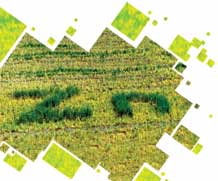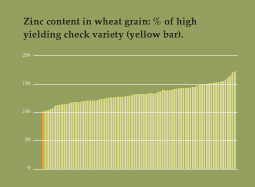January, 2005
 Thanks to pioneering research in Turkey, the links between zinc-deficient soils, plants, people, and continued malnutrition and poverty have been clearly articulated. Few other countries in the world are as well placed to show how plant breeding research can limit the impact of zinc deficiency on crop and human health. So what’s the next step?
Thanks to pioneering research in Turkey, the links between zinc-deficient soils, plants, people, and continued malnutrition and poverty have been clearly articulated. Few other countries in the world are as well placed to show how plant breeding research can limit the impact of zinc deficiency on crop and human health. So what’s the next step?
In her work as a medical doctor and nutritionist, Prof. Ayhan Çavdar saw many women who could not give birth to healthy children. They had repeated miscarriages and stillbirths. Their babies had agonizing defects of the central nervous system, such as spina bifida, in which the spine fails to close properly, and anencephaly, characterized by an undeveloped brain and incomplete skull. One 18-year-old woman had already miscarried two anencephalitic fetuses. This devastating condition had a surprisingly simple treatment. Çavdar measured the levels of zinc in the young woman’s blood serum, plasma, and hair. They were extremely low. She prescribed zinc supplements for five months. The young woman conceived and gave birth to a healthy child after an uneventful pregnancy.
Zinc deficiency is implicated in health problems throughout the world (see box). The causes and consequences of the problem have been particularly well studied in Turkey, where Çavdar says “a nutrition-related, zinc-deficient milieu exists.”
Wheat is part of that milieu. Most people in Turkey and neighboring countries rely heavily on wheat as a staple. In rural areas, people can consume more than 500 grams of bread every day. Throughout West Asia and North Africa, wheat can constitute from 40 to 60% of daily caloric intake, compared with 21% in Europe or 20% worldwide. People risk zinc deficiency when they subsist on white bread, white rice, or other cereals and consume few vegetables, red meat, or other animal protein.
The Missing Zinc
The widespread zinc deficiency in Turkey’s soils and crops, including wheat, is considered a major
reason for the relatively high incidence of zinc deficiency in its people. In the early 1990s, researchers started a NATOsponsored project in Central Anatolia, Turkey’s major wheat growing area, to investigate the extent and significance of zinc deficiency in soils, plants, foods, and people. Partners included Çukorova University in Adana, the Transitional Zone Agricultural Research Institute in Eskisehir, the Bahri Dagdas International Agricultural Research Center in Konya, the Research Institute of Rural Affairs in Sanliurfa, CIMMYT and Advanced Research Institutes in Australia, Germany, and the USA.
The project, led by Prof. Ismail Çakmak (then with Çukurova University, now with Sabanci University), built on the work of Dr. Robin Graham from Adelaide University in Australia and Mufit Kalayci from the Transitional Zone Agricultural Research Institute in Eskisehir, who had shown the effects of zinc on plant growth and yield. Some wheat varieties, especially those developed from local landraces, used zinc much more effectively than others. Zinc application increased wheat yields by 5-500%, depending on location and soil zinc levels. Also seed that had higher zinc content yielded better than seed with low content.
Çakmak recalls that “when farmers saw the results with zinc fertilizer, they said, ‘Something good like aspirin has come!’ ”Because of the impressive project’s findings, fertilizer companies started producing zinc fertilizer. “Today, ten years after the problem was solidly diagnosed, Turkey uses 300,000 tons of zinc fertilizer. This is a success story,” emphasizes Çakmak. The Ministry of Agriculture estimates that the economic benefit from zinc fertilization in Turkey is about USD 150 million per year.
No Happy Ending—Yet
Plants that get a high dose of zinc fertilizer do not necessarily accumulate enough zinc in the grain to improve human nutrition. Some varieties cannot draw much zinc from the soil. Others easily extract zinc from the soil but cannot make good use of it. Finally, not every farmer can afford zinc fertilizer, and not every country provides it.
“Wheat varieties and landraces, and wheat’s wild relatives, have the genes to solve the zinc problem,” says Hans-Joachim Braun, director of CIMMYT’s Rainfed Wheat Systems Program and participant in the NATO project.
Getting Good Genes
Turkish wheat landraces and cultivars that use zinc efficiently are being combined with wheat varieties developed in the Turkey- CIMMYT-ICARDA International Wheat Improvement Program (IWWIP) that have resistance to yellow rust and root diseases. “We’re evaluating about 180 wheat lines with these traits right now,” says Çakmak. “They’re showing very high levels of zinc efficiency when grown in zinc-deficient soils.” Çakmak and colleagues also found that wild relatives of wheat (Triticum monococcum, T. diccocoides, and Aegilops tauschii) tolerate zinc-deficient soils well compared to bread wheat. “Many of the wild wheats and Aegilops species that exhibit very high tolerance to zinc-deficient soils originated in Turkey,” says Çakmak, “very probably because Turkey has such zincdeficient soils.” They feel this valuable trait can easily be passed to improved bread wheats. Researchers also have high hopes that rye can contribute a similar genetic advantage to wheat.
With funding from DANIDA, CIMMYT evaluated accessions from its wheat genebank for cultivars that produced zinc-rich grain, and considerable variation was found. Çakmak and his team, together with collaborators from Çukurova University (Hakan Ozkan),Tel Aviv University (Eitan Millet), and Haifa University (Eviatar Nevo), have identified wild and primitive wheats from the Fertile Crescent that have grain with seven times as much zinc as modern wheat varieties. Preliminary results also suggest that the grain of wild species has higher levels of proteins and amino acids that make it easier for people to absorb micronutrients such as zinc.
“We have access to nearly 10,000 unique accessions of wild relatives from the Fertile Crescent,” observes Çakmak. “Other research groups are not working with these materials. Because Turkey has zinc deficiency not only in soils and plants but also in people, we’re ideally suited to screen a range of crops for the HarvestPlus program.” (See box below)
 HarvestPlus for a More Nutritious Harvest HarvestPlus for a More Nutritious Harvest
Zinc deficiencies have serious consequences for health. Because there is no widely accepted method for measuring zinc deficiency, no firm estimates are available on the number of people who are zinc deficient. But billions are at risk for zinc deficiency, with the prevalence highest for South and Southeast Asia and Africa. Zinc supplementation has been shown to reduce by a third the effects of common childhood infections, especially diarrhea, pneumonia, and possibly malaria. In addition, zinc deficiency is an important cause of stunting.
The white bars in the figure above show the zinc content of wheat lines that are far along in the breeding process, of excellent agronomic type, and into which CIMMYT breeders have incorporated high levels of zinc (172% of check, in the best line). The best will be used to transfer this trait to other wheat varieties and for studies in which DNA markers will help researchers identify genes associated with high zinc content. |
For more information: h.j.braun@cgiar.org
 As part of its contribution to HarvestPlus, the CGIAR’s global alliance to breed and disseminate crops for better nutrition, CIMMYT is developing nutritionally enhanced wheat varieties that will automatically increase people’s intake of essential dietary elements like zinc. Given that CIMMYTderived spring bread wheat varieties are planted on 80% of the global spring wheat area, the impacts could be wide-ranging.
As part of its contribution to HarvestPlus, the CGIAR’s global alliance to breed and disseminate crops for better nutrition, CIMMYT is developing nutritionally enhanced wheat varieties that will automatically increase people’s intake of essential dietary elements like zinc. Given that CIMMYTderived spring bread wheat varieties are planted on 80% of the global spring wheat area, the impacts could be wide-ranging.